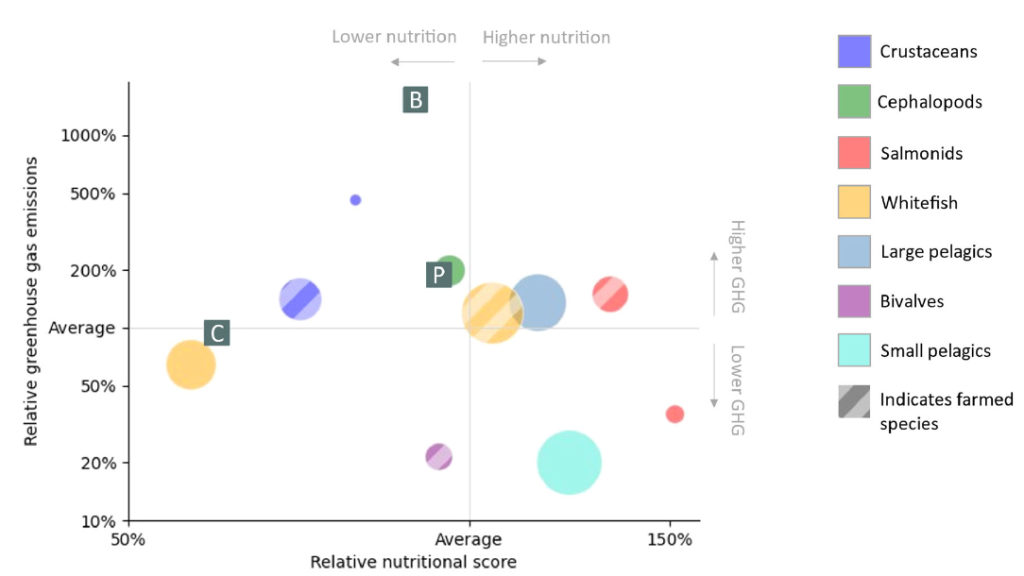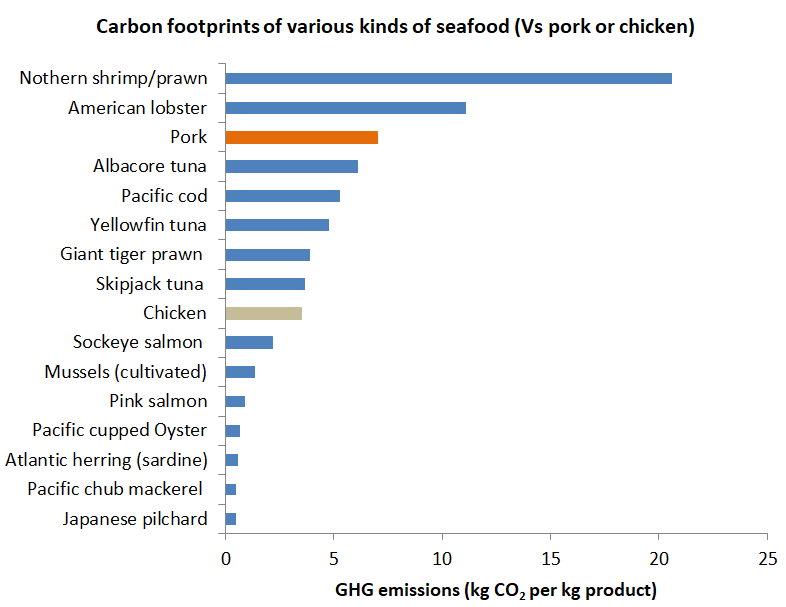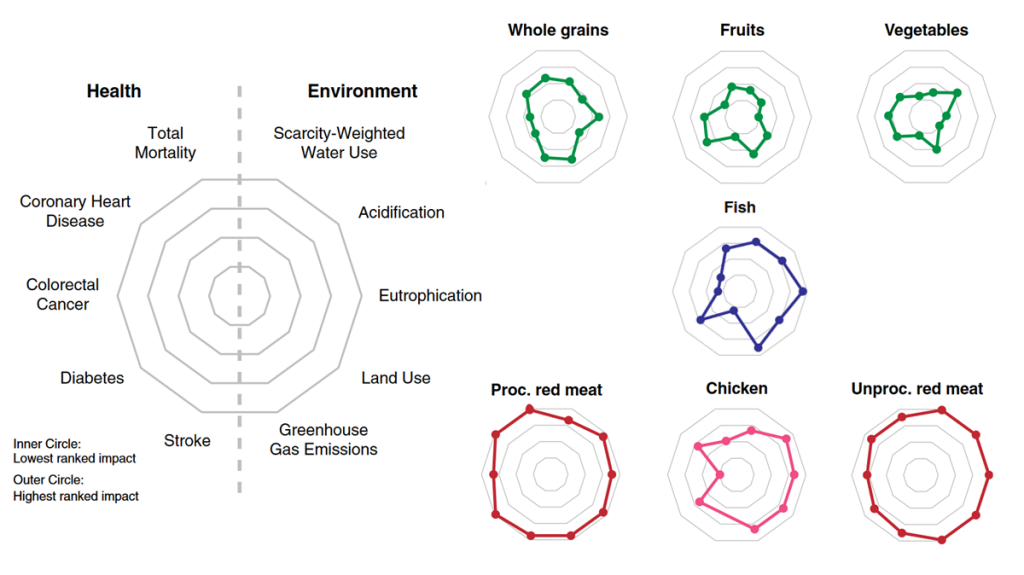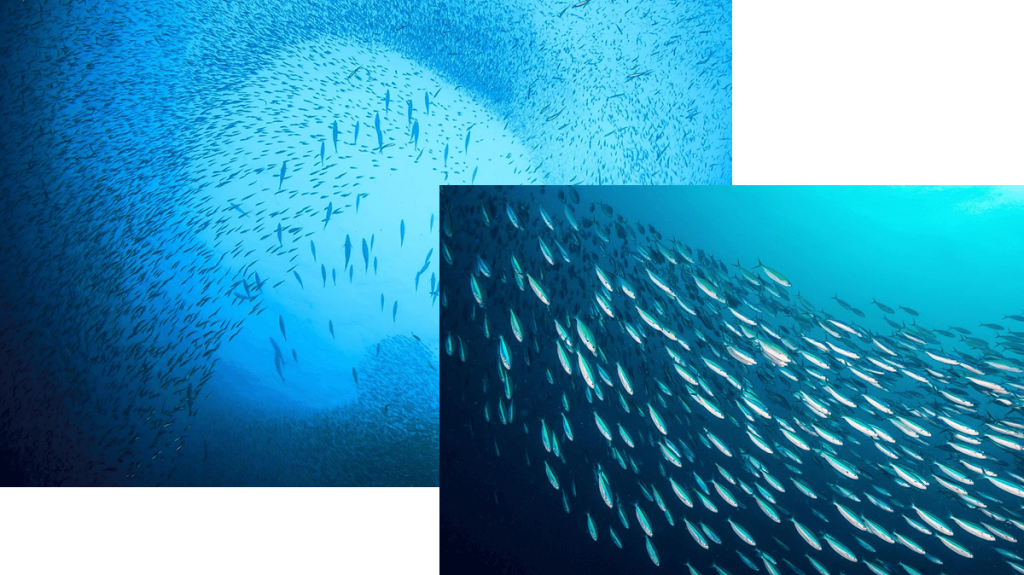What kind of seafood should you buy if you want to keep your environmental footprint as low as possible? Well, first off, is fish actually a better choice than meat? Not always – it depends on the comparison – but it’s fair to say that some types of seafood are generally more ethical and sustainable than meat. Wild fish stocks have a free life until caught, unlike intensively raised farm animals. As long as they are not overexploited, fish populations can be sustained by nutrient cycles and the energy from the sun (the food chain begins with photosynthetic algae). It’s a food source that doesn’t compete for agricultural land use.
However, we have put enormous pressure on the oceans due to overfishing, killing of non-target species (whales, dolphins, turtles, etc.), pollution from abandoned or lost fishing gear, destruction of sensitive habitats such as mangroves and (for some kinds of seafood) surprisingly large carbon footprints.
Of course, the best approach is to switch as much as possible from animal-based to plant-based diets. Some people make this switch in one jump but for others it’ll be a series of steps such as giving up meat but still eating a little fish. When I stopped eating meat, back in secondary school, I did eat fish for the first couple of years (seeing it as less problematic) and then gave it up too. As a result, I haven’t had much cause to research sustainable fish for my own part – I have a cat to thank for that inspiration 😉
I’ll do a full post on ethical cat food (including vegan options, which are gaining acceptance) in the near future as I think the time is right for that topic. But for now I’ll stick to this subtopic, in a feline’s hierarchy of interests, of sustainable seafood.
Our seafood options do range widely in terms of social and environmental impacts, so our specific choices will make a big difference. One environmental impact that varies a lot is carbon footprint, so let’s start there!
Comparing the carbon footprints of seafood
A paper published late last year in Nature Communications examined both greenhouse gas (GHG) emissions and nutritional content of various kinds of seafood to help us make good choices. The main findings are summarized in the figure below (the best options are in the lower right quadrant of the graph).

The main takeaway from this data is that three kinds of seafood score best for low GHG emissions – small pelagic fish, farmed bivalves, and wild salmonids. Here’s an outline of what these categories include:
Small pelagics are the smaller fish that live in the open sea (not by the shore or ocean floor) – sardines, herring, mackerel, anchovies, etc. They tend to swim in schools and are prey to larger pelagic fish such as tuna and sharks.
(Farmed) Bivalves are molluscs that are contained in a hinged shell – mussels, oysters, clams, cockles, and scallops.
Wild Salmonids include (not surprisingly) salmon as well as trout, char, and other fish in the Salmonidae family.
The baddies of the seafood world in terms of carbon footprint (what an anthropomorphic statement!) are the wild crustaceans (shrimp and lobster). It’s not the wild crustaceans emitting all that carbon – they’re not that wild! – It’s us, fishing for them, of course. If you’ve ever seen TV shows like Deadliest Catch you know how long diesel-fueled trawlers can be out on the sea before bringing back a few prized king crabs. But there are also other factors, such as large amounts of other species caught along with seafood like shrimp – this bycatch can be very wasteful.
Note the scale on the left axis – GHG emissions for crustaceans are almost five times higher than the seafood average and above that of pork. At the other end of the scale, the small pelagics weigh in at only one fifth of seafood’s average carbon footprint. You can also see from the crustaceans’ position on the left side of the graph that they also score badly in terms of nutritional content.
Below is a chart from the same data, showing the specific carbon footprints of various kinds of seafood (with chicken and pork included again, for comparison). The average carbon footprints of small fish such as sardines, mackerel and anchovies are WAY lower than those of meat. For the same carbon footprint of 1 kg beef, you could have 100-200 kg of sardines, for example. That’s an insane comparison that I feel people should know, but virtually nobody does. Bivalves (mussels and oysters) and salmon also have low carbon footprints relative to other seafood or meat options.

Other issues – bycatch, impact on ecosystem
Of course carbon footprint isn’t the only factor to consider. I can show you this graphic from 2019 PNAS paper, Multiple health and environmental impacts of foods to give you a rough idea how fish lies roughly in the middle between red meat and veggies when it comes to environmental impact (and health):

However, as we saw above, carbon footprint varies more than 25-fold between shrimp or lobster at the high end versus sardines and mackerel at the low end. The single dot for GHG emissions in the web plot above may capture the midpoint but we need to remember that the range is extremely wide and depends on the specific variety of seafood. Like GHG emissions, most of the other social and environmental impacts of seafood also vary widely depending on what you choose to buy.
On top of their small carbon footprint, small pelagic fish are also favorable from other perspectives. Most small pelagic species, particularly sardines, reproduce fast and are therefore capable of rapid population growth and adaption to changing environmental conditions. Because they swim in schools in the open ocean, the fishing methods used (purse seines) are less prone to bycatch issues. Other kinds of fishing such as bottom trawling (e.g., for shrimp) can result in up to two thirds of the catch being discarded as bycatch.
Shrimp, the most popular seafood in America, has been responsible for much environmental damage, whether fished by bottom trawling or farmed. Shrimp farming has been responsible for an estimated 25% of global mangrove destruction (although some farmers are now attempting to reverse this). You can read more about the environmental impact of shrimp in this Cal Academy of Sciences post on sustainable seafood. The Guardian exposed the prevalence of human slavery in the shrimp fishing industry off Thailand (shrimp that was sold in leading retailers such as Costco, Walmart, and Tesco). On top of all that, remember that wild crustaceans such as shrimp have the highest carbon footprints in the seafood world – often higher than pork or chicken.
You can imagine my excitement, when I found a vegan breaded shrimp that I loved and that also satisfied several shrimp-eating friends! You can still buy these at the Grocery Outlet in the US for only $1.50 per box, so it’s a low-risk thing to try. You can read more about that and the negative impacts of the shrimp industry in my post over on Ethical Bargains.

Where does all of this leave us? Well, we can start by selecting the seafood with lower carbon footprint – small pelagic fish, farmed bivalves, and wild salmonids. If you (or your cat) have a hankering for tuna, which has a carbon footprint slightly above seafood’s average, then aim for pole-and-line caught tuna to mitigate the bycatch issue. Ignore any messages such as “wild caught” and avoid these brands if that’s all they have to say. The Mind Fish Co. sells canned skipjack tuna that’s pole-and-line caught and also certified fair trade.
The last step is to attempt to buy fish from regions with healthy stock levels that are not threatened by overfishing. Here’s a quick look at that.
How to avoid fish that’s threatened by overfishing
If everyone decided to replace shrimp with sardines, we may be in danger of creating a sardine shortage and, in turn, threaten stocks of larger fish, birds, and mammals that depend on the sardines. So it’s a good idea to look out for two things whenever you buy fish.
1. Check for whether fish stocks from that region are healthy. The Monterey Bay Aquarium’s Seafood Watch is the most trusted guide in this respect. Honestly, I find it hard to find the exact information that I need from Seafood Watch, and I can imagine that plenty of consumers find it frustrating. However, a few things are fairly clear – for example that farmed bivalves (mussels, oysters, clams, and scallops) are among Seafood Watch’s “best choices.” Small pelagic fish such as sardines haven’t been covered by Seafood Watch until recently – they rate sardines from Japan or Morocco as a “good alternative.”
2. Check the brand (or fresh fish) that you’re thinking of buying to see if the specific fishery is certified sustainable. MSC is the most common certification scheme but Friend of the Sea is also valid.
I’ll just quickly mention one paper that examined fisheries certified by both Friend of the Sea and the larger Marine Stewardship Council (MSC), concluding that:
It is still reasonable to buy certified seafood, because the percentage of moderately exploited, healthy stocks is 3–4 times higher in certified than in non-certified seafood. – Marine Policy, 2012.
Despite all of this being quite confusing, the rising popularity of canned sardines and anchovies indicates that some people are paying attention and willing to change their habits. Tinned sardines also stay fresh for many years, helping to reduce food waste, and the aluminium tins can be recycled with high efficiency.
In a recent post on Ethical Bargains I evaluated canned Season sardines (Friend of the Sea certified, from off the coast of Morocco) so please check out that post if you want more information on sardines or seafood certifications. They have also been approved by my feline friend 🙂
Further reading:
Sophie’s vegan breaded shrimp, replacing one of the most popular and environmentally damaging kinds of seafood.
Season sardines, with more discussion on sardines and general seafood certifications.


Good to know I’m eating sustainably, thank you
LikeLiked by 1 person
Thanks. Great information!
LikeLiked by 1 person